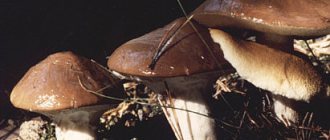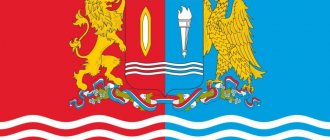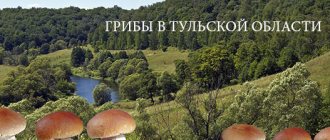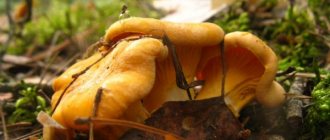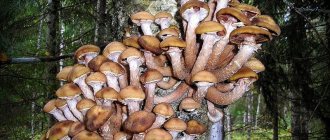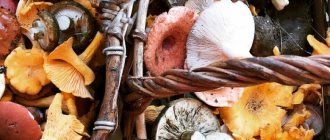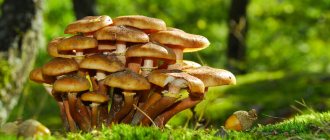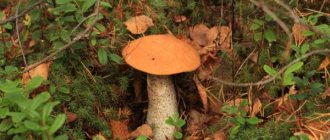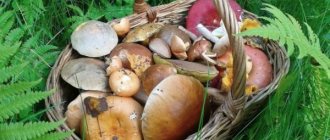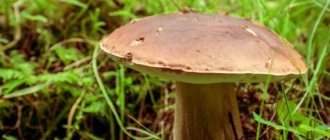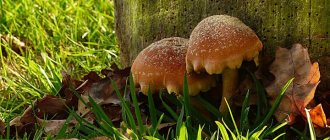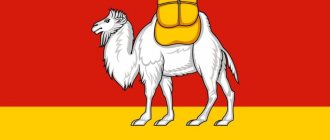What is the most important thing for a mushroom picker who goes into the forest on a “silent hunt”? No, not a basket at all (although you will also need that), but knowledge, especially regarding which mushrooms are poisonous and which ones can be safely put in the basket. Without them, an outing for a forest delicacy can smoothly turn into an urgent trip to the hospital. In some cases it will turn into the last walk of your life. To avoid disastrous consequences, we bring to your attention brief information about dangerous mushrooms that should not be cut off under any circumstances. Take a closer look at the photos and forever remember how they look. So let's begin.
The most dangerous mushroom is toadstool
Among poisonous mushrooms, the first place in toxicity and frequency of fatal poisoning is occupied by toadstool. Its venom is stable before heat treatment, and also has delayed symptoms. After tasting mushrooms, you can feel like a completely healthy person for the first day, but this effect is deceptive. While precious time is running out to save a life, toxins are already doing their dirty work, destroying the liver and kidneys. From the second day, symptoms of poisoning manifest themselves as headache and muscle pain, vomiting, but time is lost. In most cases, death occurs.
Even just for a moment touching the edible mushrooms in the basket, the poison of the toadstool is instantly absorbed into their caps and legs and turns the harmless gifts of nature into a deadly weapon.
The toadstool grows in deciduous forests and in appearance (at a young age) slightly resembles champignons or greenfinches, depending on the color of the cap. The cap can be flat with a slight convexity or egg-shaped, with smooth edges and ingrown fibers. The color varies from white to greenish-olive, the plates under the cap are also white. The elongated leg at the base expands and is “shackled” in the remains of a film-bag, which hid a young mushroom underneath, and has a white ring on top.
In a toadstool, when broken, the white flesh does not darken and retains its color.
Such different fly agarics
Even children know about the dangerous properties of fly agaric. In all fairy tales it is described as a deadly ingredient in the preparation of a poisonous potion. It’s so simple: the red-headed mushroom with white spots, as everyone saw it in illustrations in books, is not at all a single specimen. Besides it, there are other varieties of fly agaric that differ from each other. Some of them are very edible. For example, Caesar mushroom, ovoid and blushing fly agaric. Of course, most species are still inedible. And some are life-threatening and it is strictly prohibited to include them in the diet.
The name “fly agaric” is made up of two words: “flies” and “pestilence”, that is, death. And without explanation, it is clear that the mushroom kills flies, namely its juice, which is released from the cap after sprinkling it with sugar.
Deadly poisonous fly agaric species that pose the greatest danger to humans include:
- Poisonous (red). Grows in forests under birch and spruce trees. The globular cap is most often bright red, although there are also orange varieties. A rich scattering of large growths is visible across the entire surface, however, they are weakly adherent and are washed off after rain. The flesh is dense, white, with a subtle mushroom aroma. The white leg is tall, strong and powerful, with the remains of a cap in the form of flakes (also white).
- Panther (leopard). It lives among pine trees and is distinguished by a characteristic spotted cap of a brownish color with white growths. The pulp is white, watery, and smells like fresh radish. The leg is cream-colored, twice ringed in the lower part, the walls are quite thick, but have a hollow space inside.
- White stinking (often called white toadstool by mushroom pickers). It grows among the hills in deciduous-coniferous forests, is distinguished by the specific white color of the entire mushroom body and the pungent smell of bleach, for which it is named. The surface of the cap is most often shiny, but sometimes large white flakes are visible on it. The long stalk is almost always curved, with a tuberous base.
- Bright yellow (lemon). Grows mainly on sandy soil. The owner of a yellow hat with a smooth skin, sometimes sparse white flakes are visible on it. The light leg is squat and fragile, with a thick ring at the bottom.
Characteristics of edible mushrooms and their description
Among the noble representatives of edible, tasty and healthy mushrooms, there is a special group, which is usually characterized by one word “toadstools”, because they are all poisonous or deadly poisonous, there are about 30 species.
They are dangerous because they usually grow next to edible ones and often look similar to them. Unfortunately, only a few hours later it turns out that a dangerous mushroom was eaten, when the person was poisoned and ended up in the hospital. To avoid such serious troubles, it would be useful to look again at the photos, names and descriptions of edible forest mushrooms before going on a “quiet hunt”.
You can start with the first category, which includes the most noble, high-quality mushrooms with the highest taste and nutritional qualities.
Porcini mushroom (or boletus) - it is given the palm, it is one of the rarest among its relatives, the beneficial properties of this mushroom are unique, and the taste is the highest. When the mushroom is small, it has a very light cap on top, which changes its color to yellowish-brown or chestnut with age. The underside is tubular, white or yellowish, the flesh is dense, the older the mushroom becomes, the more flabby its flesh becomes, but its color does not change when cut. This is important to know, since the poisonous gall mushroom is similar in appearance to the white one, but the surface of the spongy layer is pink, and the flesh turns red at the break. In young boletus, the legs have the shape of a drop or a barrel, with age it changes to cylindrical.
It is most often found in summer, does not grow in groups, and can be found in sandy or grassy meadows.
Boletus is a delicious mushroom, rich in microelements, known as an absorbent that binds and removes harmful toxic substances from the human body. The cap of the boletus is a muted brown shade, convex, reaching a diameter of 12 cm, the stem is covered with small scales, and widened towards the base. The pulp does not have a specific mushroom smell; when broken, it acquires a pinkish tint.
Mushrooms love moist soil, you should go for them in a birch grove after a good rain, you need to look right at the roots of birch trees, they are found in aspen forests.
Camelina is a mushroom that got its name due to its special carrot-red color, the cap is an interesting funnel-shaped, with a depression in the middle, circles are visible from the depression to the edges, the lower part and the stem are also orange, the plastics turn green when pressed. The pulp is also bright orange, gives off a light resinous aroma and taste, the milky juice released at the break turns green, then turns brown. The taste of the mushroom is highly valued.
Prefers to grow in pine forests on sandy soils.
The real milk mushroom is considered and called “the king of mushrooms” by mushroom pickers, although it cannot boast that it is suitable for use in various processing: basically, it is eaten only in salted form. The cap at a young age is flat-convex, with a slight depression, turning into a funnel-shaped, yellowish or greenish-white with age. It has transparent, glassy-like diametric circles - one of the characteristic signs of milk mushrooms. The plates from the stem extend to the edge of the cap, on which a fibrous fringe grows. The white, brittle pulp has a recognizable mushroom smell; the white juice, as it weathers, begins to turn yellow.
Next, we can continue to consider the description of edible mushrooms belonging to the second category, which may be tasty and desirable, but their nutritional value is somewhat lower; experienced mushroom pickers do not ignore them.
Oiler is a genus of tubular mushrooms, it got its name because of its oily cap, initially red-brown, then turning into yellow-ocher, semicircular with a tubercle in the center. The pulp is juicy, yellowish in color, without changing when cut.
Boletus (aspen) - while young, the cap is spherical, after a couple of days its shape resembles a plate on a stocky leg elongated to 15 cm, covered with black scales. A cut of the flesh turns from white to pink-violet or gray-violet.
Polish mushroom - belongs to the valuable, elite mushrooms, has some similarities with the porcini mushroom, its cap is chestnut-brown, first curled downwards, in adult mushrooms it curls up, becomes flatter, in rainy weather a sticky substance appears on it, the skin separates with difficulties. The leg is dense, cylindrical-shaped up to 4 cm in diameter, often smooth, with thin scales.
Speckled oak mushroom - similar in appearance to the white mushroom, but it has a slightly different color, black-brown, the stem is a pale yellowish color with reddish inclusions. The pulp is fleshy and dense, bright yellow, turning green at the break.
Small but deadly ragged mushroom
The poisonous mushroom got its name from its peculiar structure: often its cap, the surface of which is covered with silky fibers, is also decorated with longitudinal cracks, and the edges are torn. In the literature, the mushroom is better known as fiber and has a modest size. The height of the leg is slightly more than 1 cm, and the diameter of the hat with a protruding tubercle in the center is a maximum of 8 cm, but this does not prevent it from remaining one of the most dangerous.
The concentration of muscarine in the pulp of the fiber exceeds the red fly agaric, and the effect is noticeable within half an hour, and within 24 hours all symptoms of poisoning with this toxin disappear.
Features of poisoning
The most common signs of poisoning by poisonous mushrooms are stomach upset, nausea, vomiting, diarrhea, fever, and less often dizziness. There is also a weak pulse and cold extremities.
If there are any signs, the most important thing is to go to the hospital and see a doctor as quickly as possible. Because it is very difficult to deal with poisons on your own and you cannot waste time, so as not to lead to complications.
Beautiful, but “crappy mushroom”
This is exactly the case when the title matches the content. It’s not for nothing that the false valu mushroom or horseradish mushroom is called such an indecent word by the people - not only is it poisonous, but also the flesh is bitter, and the smell it emits is simply disgusting and not at all mushroom-like. But thanks to its “aroma”, it will no longer be possible to gain the trust of a mushroom picker under the guise of russula, which valui is very similar to.
The scientific name of the mushroom is “hebeloma adhesive.”
False tree grows everywhere, but most often it can be seen at the end of summer on the light edges of coniferous and deciduous forests, under oak, birch or aspen. The cap of a young mushroom is creamy-white, convex, with the edges turned down. With age, its center bends inward and darkens to a yellow-brown color, while the edges remain light. The skin on the cap is nice and smooth, but sticky. The bottom of the cap consists of adherent plates that are gray-white in young valuei and dirty yellow in old specimens. The dense, bitter pulp also has a corresponding color. The leg of the false valuu is quite high, about 9 cm. It is wide at the base, tapers further upward, and is covered with a white coating similar to flour.
A characteristic feature of the “horseradish mushroom” is the presence of black inclusions on the plates.
Benefits and harms
Forest mushrooms have a number of positive properties. They are nutritious and at the same time low in calories due to their high water content. Therefore, they are useful in dietary nutrition. The presence of vitamins in them strengthens the immune system and increases resistance to viruses.
Some types of mushrooms are used for medical and pharmacological purposes to create new drugs. A number of mushrooms have been used for a long time and successfully in alternative - folk medicine. However, we should not forget that when starting to use any medicine, especially one obtained independently from natural raw materials, you must consult with your doctor. These remedies cannot be the main ones in the treatment of diseases. They are complementary therapy.
The poisonous twin of summer honey mushrooms: sulfur-yellow honey fungus
Everyone knows that honey mushrooms grow on stumps in friendly flocks, but among them there is a “relative” that looks practically no different from tasty mushrooms, but causes severe poisoning. This is a false sulfur-yellow honey fungus. Poisonous lookalikes live in clusters on the remains of tree species almost everywhere, both in forests and in clearings between fields.
The mushrooms have small caps (maximum 7 cm in diameter) of gray-yellow color, with a darker, reddish center. The pulp is light, bitter and smells bad. The plates under the cap are tightly attached to the stem; in the old mushroom they are dark. The light leg is long, up to 10 cm, and smooth, consisting of fibers.
You can distinguish between “good” and “bad honey fungus” by the following characteristics:
- The edible mushroom has scales on its cap and stem, while the false mushroom does not;
- The “good” mushroom is dressed in a skirt on a leg, the “bad” one does not have one.
Satanic mushroom disguised as boletus
The massive stem and dense flesh of the satanic mushroom make it look like a porcini mushroom, but eating such a beauty is fraught with severe poisoning. Satanic bolete, as this species is also called, tastes quite good: there is no smell, no bitterness characteristic of poisonous mushrooms.
Some scientists even classify bolet as a conditionally edible mushroom if it is subjected to prolonged soaking and prolonged heat treatment. But no one can say exactly how many toxins boiled mushrooms of this type contain, so it’s better not to risk your health.
Externally, the satanic mushroom is quite beautiful: the dirty white cap is fleshy, with a spongy yellow bottom that turns red over time. The shape of the leg is similar to a real edible boletus, just as massive, in the shape of a barrel. Under the cap, the stem becomes thinner and turns yellow, the rest is orange-red. The flesh is very dense, white, only pinkish at the very base of the stem. Young mushrooms have a pleasant smell, but older specimens give off a disgusting smell of spoiled vegetables.
You can distinguish Satanic boletus from edible mushrooms by cutting the flesh: when it comes into contact with air, it first acquires a red tint and then turns blue.
Purple, delicate, “sea”. rare mushrooms of the Murmansk region
In recent weeks, it has been pouring like buckets in the Arctic. But it’s still warm, so the rain is worth rejoicing at. After all, this is the kind of weather you need for a good mushroom harvest. By the way, prey from quiet hunting is already being collected and sold in full force, and the first redheads arrived back in June.
In the forest, in addition to the usual mushrooms like russula and boletus, you can also find those that will surprise the eye with their shape and color. Don’t rush to trample them, mistaking them for toadstools. After all, it is possible that you have found a rare mushroom listed in the Red Book of the Murmansk Region! He must be pardoned. And take a photo to show off your find.
This mushroom seems to have emerged from the depths of the sea, it looks so much like coral. Most often, the coral hedgehog can be found on stumps in the Lapland and Kandalaksha nature reserves along the road from Apatity to the Murmansk-St. Petersburg highway. It has become rare due to the fact that mushroom pickers often pick it - it’s beautiful, after all.
The elongated microstoma looks more like a flower. Loves mixed and coniferous forests. Kandalakshans and Kirov residents, be careful: this mushroom loves the Khibiny Mountains and Mount Krestovaya. It is not recommended to eat it, because scientists have not determined its toxicity.
Maybe you didn’t expect to find a yellow chanterelle on the Red Book list, but in the Murmansk region it is a rare mushroom! If you see that some mushroom picker is selling it, then tell them off - a habitual inhabitant of the forests of the middle zone, in our country it is on the verge of extinction. You can admire the chanterelle, for example, in Pasvik or the Luvenga tundra.
In our philistine opinion, we would say that it is more black in life, but in the Red Book this mushroom is called purple cobweb. You can find it in the Lapland and Kandalaksha nature reserves. You can eat it, although it looks unappetizing. But is it worth it? Redheads are both nicer to look at and tastier.
Sarcosoma globulus bears little resemblance to a mushroom, and its name sounds like a disease. This barrel loves to hide in the moss of the Varzuga nature reserve. A liquid forms inside it, in which 18 fatty acids and a number of amino acids were found. This is why some scientists (without much evidence) believe that sarcosomes can even treat cancer.
BY THE WAY
Edible-inedible
In total, 18 mushrooms are listed in the Red Book of the Murmansk Region. Some are found in similar publications in Finland, Norway and Karelia. They are considered rare only here, but in other countries they are more common. Most of the “Red Book” mushrooms have a note that their edibility has not been studied or that they can be eaten. But is it worth doing? Then you'll spend the rest of the summer in the hospital.
Svinushki - mushrooms similar to milk mushrooms
The debate about the edibility of pig mushrooms was stopped in the early 90s, when all types of these mushrooms were officially recognized as dangerous to human life and health. Some mushroom pickers continue to collect them for food to this day, but this should not be done under any circumstances, since pig toxins can accumulate in the body and symptoms of poisoning do not appear immediately.
LiveInternetLiveInternet
Part one
Moscow – Vologda – Vytegra – Petrozavodsk – Murmansk – Rybachy Peninsula
This year, alas, it was not possible to make a long summer expedition to the Pamirs, Central Tien Shan and Mongolia. Life made unexpected adjustments to our plans and left only one interesting route for me at this time - the Russian North. True, what is summer without golden beaches and the sea, or even the ocean? I even agree to the ocean beach, I agree to the Arctic, I agree to the early northern autumn.
This time my crew did not have a navigator, but the expedition included St. Petersburg guys, so no particularly extreme adventures were expected at first glance, but of course, first things first.
Everything was prepared, the route was agreed upon, and on the evening of August 19 I set off towards Petrozavodsk. The first night was on the shores of Lake Belye, several tens of kilometers beyond Vologda. That same night, a new sleeping place in Padzherik was successfully tested. Great, despite the minor shortcomings of a particular solution.
The left or right bank of the Onega, I was faced with a question. Remembering the impressions of the June trip to Besov Nos, it was decided to go to Petrozavodsk along the left side of Lake Onega through the Vytegra and the mighty northern river Svir. They told me about the quality of this road, but my curiosity turned out to be stronger. It's a sad and slow grader, especially when you don't want to flatten the tires.
Really beautiful places. We will definitely get to know this region better. The 180 km grader from Vytegra to Petrozavodsk and the crossing of the Svir took me almost 6 hours of road time, which is much more if you go around Onega on the right side through Medvezhegorsk.
Before reaching Belomorsk, late in the evening of August 20, on the banks of the magnificent Shuezer, the long-awaited unification of the Moscow and St. Petersburg crews took place.
At the end of the next day, a few hunters for arctic mushrooms overcame the border guard post at Titovka and set up camp near the “Drunken Stream”.
The polar mushroom hunt has begun...
The capricious autumn weather gave us a generous gift - blue sky, bright sun and a light sea breeze. Sometimes it happens THERE...
We headed to explore the Sredny Peninsula along the Malaya Volokovaya Bay. The tundra was actively transforming into purple colors and was replete with a huge number of mushrooms. It was decided to go around Sredny clockwise and then walk through the center with an exit through the Korabelny stream.
After examining the location of the former Bulatny garrison, we headed towards Cape Zemlyanoy. The western coast of the Sredny Peninsula, as well as the Musa-Tunturi ridge, hid numerous traces of the terrible and cruel events of 70 years ago. Everywhere we see pillboxes and trenches. Yes, this is already a traditional tourist route in this place. The battery of the 50s, the sacred stones of the Sami - places have long been known to a wide range of travelers.
I have long dreamed of a house by the sea. An unrealistically mesmerizing view opens from the window of this hut...
Before traveling to these places, I strongly recommend reading the book “Orphaned Shores” by M.G. Nuts. He describes the history of these places very interestingly and in detail.
We set up our next camp at Cape Zemlyanoy. Cozy and beautiful place. Mushrooms, mushrooms and more mushrooms. Live and dried. I have never seen dried mushrooms growing before.
A clear northern night at the end of August gave us the Northern Lights. Weak and timid, but fantastically fascinating. I've never seen anything like this before. They say that the aurora is an extremely rare phenomenon in these places at the end of August. We're lucky so far...
Another day - we decide to walk through the center of Sredny. Through the Pyshka garrison and the Korabelny stream. The first loss is the drive belt on the American UAZ. An hour of work and we continue our voyage.
There was a bathhouse, about 20 years ago.
Before Pummanaki we are greeted by the first interesting ford across the river. Roll out. Quite harmless if you choose the right trajectory, otherwise you can bathe even our trained horses.
Another fortification in the center of Sredny, erected during the Great Patriotic War by a penal battalion.
The road from Pyshka through Korabelny to Ozerok is an unforgettable stone trial. Even for 33 wheels this is not a very easy section. Here are the first losses for the Pajero - I finally tear off the unnecessary damper of the rear gearbox. Further on, Korabelny Stream is better, but it was also passed without loss.
Our next overnight stay finds us already at Rybachy. Incredibly, for the third day in a row, Rybachy pleases us with magnificent sunny weather.
The next day we are planning a trek to Tsypnavalok via the Zubovsky tract. We are considering 500-meter maps of Rybachy. The idea arose to check the possibility of passage to Tsypnavalok counterclockwise through metro Gorodetsky and metro Sharapov. We move along the Zubovsky tract and leave the road towards the location of the former Motka division.
From Mount Motka we are trying to determine the availability of directions in the right direction. There are directions - we will check.
We spend about 30 minutes contemplating the majestic panoramic views of Sredny and Rybachy…
Near the Ein River, continuous carpet swamps begin. It is impossible to get to Tsypnavalok in the eastern part of the peninsula in heavy off-road vehicles. Since we have no great desire to fight for several days in the local swamps, we return to the Zubovsky tract.
The weather begins to rapidly deteriorate, fog falls and, despite the middle of the day, the temperature outside is no higher than 10 degrees Celsius.
In 2 hours we overcome the Zubovsky tract. There was only one more or less deep ford with a depth of no more than 70-80 cm. There were a lot of unpleasant stones.
Numerous abandoned and plundered divisions encountered on our way leave a very painful and depressing feeling.
Behind Zubovka, the Jeep Wrangler remains without 4 rear shock absorbers. We need welding, but for now the speed of movement drops significantly.
Taking advantage of the moment, I decide to ride deep into the tundra and look at the deer. Having gone 7-8 km from the coast, I find a large herd of deer, which, when they see me, rushes away from me. Beauty.
While moving behind the herd, I didn’t notice how I went tens of kilometers deep into the tundra. Disorder.
On the way to Tsypnavalok we stop at the site of the wreck of the dry cargo ship Viktor Koryakin. Despite the inclement weather, we decide to inspect the remains of the sawn cargo ship, especially since the tide is low.
The sea is a little stormy and the rain is cold and unpleasant. The landing turned out to be quite extreme.
Late in the evening we get to Tsypnavalok. The military does not allow us further beyond Tsypnavalok - they are conducting training exercises. We set up camp near Cape Lausch.
In the morning we collect countless cloudberries. Damn tasty berry. And again mushrooms - we replenish our supplies. Not far from the camp we find the remains of a beached whale...
I slowly make my way along Cape Tsypnavalok. That's it, then only on foot. 700 meters along the reindeer moss and the open ocean. You can stand and admire these landscapes for hours. The power and grandeur of the ocean awakens many philosophical thoughts.
I see how preparations for winter are going on - a transport ship approached the shore at high tide. At low tide it opens the holds to unload coal and trucks simply drive up to the ship and load the coal into the back. They only have 6 hours to unload the ship. Then the tide comes in and the ship goes to the next village...
We fill canisters with diesel fuel from the military and set a course for Skorobeevka.
The weather allows us to enjoy the landscapes of Rybachy today.
You just have to go a little deeper into the tundra and nature reveals amazing colors.
Zubovskaya Bay welcomes you with golden sandy beaches and, of course, we cannot deny ourselves the pleasure of a beach holiday.
It is magnificent and unique to swim in the waters of the Arctic.
We didn't get to the low tide, so we'll have to take a detour.
In Skorobeevskaya Bay we see a large tent camp, a popular place, however.
Our next day ended on the shore of Cape Kekursky.
The strong wind and scorching sunset hinted to us that the weather would change. The piercing north wind was felt here today like nowhere else and like never before. And we are almost at the northernmost point of our trip.
Today is the last day on the Rybachy Peninsula. We traditionally explore the surroundings of Vaida Guba and Cape Nemetsky.
The final. The northernmost point of mainland European Russia. Then there is only the icy breath of the Arctic and the endless Northern Ocean.
A functioning locator or a modern lighthouse are not so interesting. A beautiful and harsh region.
We return along the western shore of Rybachy. Once again, a stone trial and desert tundra.
In Ozerka we find welding, bring the crossbar of the rear shock absorbers of the Jeep Wrangler into combat condition and inspect the remaining cars. The ABS sensor on the Pajer died. Strange, but it is not required here. We set up camp behind Ozerko.
The next day the weather completely deteriorated. It was decided to take the old German road to Pechenga.
I've heard a lot about this road. Indeed, the German engineering battalion in the Arctic did the almost impossible. For 70 years, neither nature nor Soviet technology could destroy this road.
We examine the remains of German positions. Nature carefully hides evidence of that war. Five centimeters of reindeer moss layer separates us from history.
German battalions left stamps of their presence in their places of deployment.
In clear weather it should be stunningly beautiful here.
Our next day ended with crossing the ford through Pechenga and crossing an active tank training ground.
In 6 days of travel, we covered almost 500 km of directions along the Musa-Tunturi Ridge, and the Sredniy and Rybachy peninsulas.
So, the first part of the Kola expedition was coming to an end.
Part two
Rybachy Peninsula – Zapolyarny (Kola Superdeep) – Teriberka – Dalnie Zelentsy – Porchnikha – Murmansk – Kandalaksha – Umba – Varzuga – Medvezhogorsk – Moscow
Today we had a so-called “Day Off” - a free day. Part of the team went to Murmansk on their own business, and part of the team decided to visit the remains of the Kola Superdeep Well.
The Kola superdeep well (SG-3) is the deepest borehole in the world. It is located in the Murmansk region, 10 kilometers west of the city of Zapolyarny, on the territory of the geological Baltic shield. Its depth is 12,262 meters. Unlike other ultra-deep wells that were made for oil production or geological exploration, SG-3 was drilled solely to study the lithosphere in the place where the Mohorovicic boundary comes close to the Earth's surface.
It was also the longest well until 2008, when it was surpassed by the Maersk Oil BD-04A oil well, drilled at an acute angle to the surface of the earth, whose length is 12,290 meters (located in the Al Shaheen oil basin, Qatar), after which in January 2011 this The well was also bypassed by the oil well of the Odoptu-Sea field of the Sakhalin-1 project, also drilled at an acute angle to the surface of the earth, with a length of 12,345 meters.
Some information about this interesting object is here: Kola Superdeep. Mysticism and reality
According to official information for 2010, SG-3 was liquidated. For us, this fact means one thing - we have a chance to find a unique laboratory that has not yet been completely looted.
On the maps, the only access to the SG-3 location is the road from Zapolyarny. We come up against the checkpoint of the Kola Mining and Metallurgical Company. There is no access using cards. The security is trying to confuse us with complicated detour routes. Despite heavy rain and dense fog, after an hour and a half of searching we find SG-3.
Here it is - a mothballed well with a depth of 12,262 meters and a diameter of 20 centimeters.
Drilling rig control
There is no one, but we are surrounded by traces of the work of “metal hunters”. It’s sad, in a few years there will be nothing here to remind you of the once legendary telescope into the mysterious inner world of the planet.
We examine the not completely looted laboratory buildings...
A large amount of abandoned measuring equipment, numerous research journals, graphs and core samples surround us.
Everything around us suggests that work at this facility was frozen back in 1991-1992.
We leave SG-3 and reunite with the team in Murmansk. There are two routes to Teriberka: through Granitny along the coast of the Barents Sea and through Severomorsk III. For the first route we do not have passes to the ZATO Severomorsk, so only the second option remains. The asphalt surface ends 80 km from Murmansk at the Teriberka – Tumanny fork. In the tundra, you come across people wandering somewhere along the side of the road, which is very strange, considering that the nearest settlements are Teriberka and Tumanny, 50 km to the East, and Severomorsk, 40 km to the West. We set up the next camp 30 km before reaching Teriberki already well after midnight.
The third day the weather did not please us - fog and rain. This happens here... On the way to Teriberka we pass the cascades of the Serebryansky hydroelectric power stations. A grader of quite tolerable quality allows you to maintain an average speed of 60-70 km/h.
At lunchtime we get to Teriberka - a depressing place, or maybe we were just unlucky with the weather. The first problem I encountered was that one of the additionally installed electromechanical hood locks jammed. The hood cannot now be opened without a special tool and a lift. A serious risk factor has appeared in case of problems with the car... Once again I am convinced that there are no accidents.
We make a decision on the further route, look at the maps for directions towards Far Zelentsy along the coastline. On our way there is a ford across the river. Voronya with an estimated tide of 3 meters. We decide to get to Voronya and assess the situation, although I have not seen any information on the Internet about the possibility of fording the river.
At the exit from Teriberka we come across the Gazprom barrier. Security reported that blasting work and construction of an access road to the future LNG plant are underway. There is no other road towards the village of Orlovka. We are trying to find a detour - to no avail. We are surrounded by carpet swamps. We turn around and return back to the fork to Tumanny.
There is also a fairly decent grader leading to Tumannoye, which allows you to maintain a speed of up to 90 km/h. Before reaching Tumany, for the first time I lose my rear license plate due to shaking... I return and after 5-6 km I find it pretty battered on the grader.
Tumanny turned out to be a fairly civilized village with several residential high-rise buildings. The weather continued to deteriorate and it was raining heavily.
We continued moving towards Dalniye Zelentsy. After the Serebryanskie hydroelectric power station, the road became much worse and large stones appeared on the road. After 30-35 km we reached our goal.
The distant Zelentsy greeted us with almost complete desertion.
The village of Dalnie Zelentsy was founded in 1935 as the Murmansk Biological Station. In the 50s, the biological station functioned as a full-fledged scientific organization and in 1958 it was reorganized into the Murmansk Marine Biological Institute. In 1989, MMBI was transferred to Murmansk, and a base for experimental work was left in Dalniye Zelentsy.
We slowly explored the almost abandoned village. The architecture of the institute's buildings is unusual for Russia. My guess is that they were built by German prisoners of war.
Despite the fact that the Institute was moved to Murmansk in the early late 80s, the infrastructure of the biological station was left here in a mothballed state. It was this institute that studied the Kamchatka crab and it was from here that it was released into the Barents Sea.
Everything that was left is mercilessly destroyed by nature and a few vandals. The main building of the biological station is gradually being destroyed.
Behind the village there is an active air defense military unit of the Air Force, although it initially seemed to us that it was abandoned. There is a lot of military equipment, but the territory is not guarded and we did not see a single living soul.
After exploring Dalniye Zelentsy, we headed to the next abandoned village - Porchnikha, which is 10-15 km from Dalniye Zelentsy. There are various legends about this village, one of which is that a nuclear submarine base was supposed to be based here. Most likely a myth, but the fact that in Porchnikha Bay until the 90s there was a reserve base for the KSF fuel department is reliable information. Fuel tanks, regeneration warehouses, and two floating berths were guarded by guards. To this day, you can see the remains of a warehouse with B-64 air regeneration units manufactured in 1972. These chemical air regeneration units are used on submarines. In the event of an emergency, the unit is activated by a special key and, as a result of a chemical reaction, pure oxygen is released and carbon dioxide is absorbed.
In Porchnikha we came across poachers who were probably hunting Kamchatka crabs.
There are no roads further beyond Porchnikha, only a walking path between the hills and swamps, despite the fact that they are marked on the maps.
The weather is unchanged - rain. By chance, inspecting the streams of water flowing from the car, I discover a serious problem with the Padzherik - faint oil stains from under the engine. The situation is complicated by the inability to both open the hood and remove the deformed protection - it is seriously damaged by stones and cannot be done without the help of a power tool. Both the front axle and the broken crankcase could have leaked. The prospects are not bright, considering that a more or less decent service in Murmansk is at least 170 km away. I decide to stop participating in the expedition at this stage and try to get to Murmansk on my own.
The overnight stay was already outside Tumanny and on the morning of August 30 I reached Murmansk. A person from the pajero4x4.ru club helped me find a good and proven service for the resuscitation of my Pajera. The owner of the service, Artyom, put everything aside and took care of the injured car. Having cut off the protection mounting bolts and examined the car, we come to disappointing conclusions - the steel engine crankcase is broken and the front axle cover is damaged. Oil is leaking from both the crankcase and the bridge. The damage is caused by elements that are designed to protect against this damage - crankcase protection and protection of the front axle coupling. I was probably lucky, I lost only 4 liters of oil out of 8. I might not have gotten out of Porchnikha on my own.
The next 5 hours were spent opening the hood lock using power tools and a lift. There was no chance of opening the lock using secret means; the cable of one of the locks was simply jammed. We will have to think something about this system. Adding oil to the bridge and installing a cold weld on the damaged crankcase - a temporary solution has been found and you can continue driving to Moscow. All 4 sheets of protection lay defeated on the expedition trunk. There was no longer any strength left to straighten and put them in place.
Another day ended in Murmansk...
The thought that the expedition ended so unexpectedly haunted me. Having reached Monchegorsk, I straighten it and install 2 protection sheets in the service. There is practically no leakage from the bridge, the patch on the crankcase holds securely. You can try to complete the expedition using the easy scenario of the Tersky Coast: Kandalaksha - Umba - Varzuga. Still, now I was completely alone - even without a navigator. At lunchtime I reach Kandalaksha and on excellent asphalt in the late afternoon I find myself in Umba. Having examined the streets of this old city, I decide to spend the night in Tetrin. I reached Tony along the coast. The sea is stormy. Beauty. Long-eared hares scatter in front of the car. They are not afraid of anything at all. I walked around the tone. The owner of this open-air museum was not there, yet I arrived without warning. But the place is certainly interesting and amazing with several guest houses. I returned to the route directly through the forest. In front of the chapel of the monk Nameless, I decide to continue moving along the Tersky coast - much more beautiful and interesting. On the way you come across the remains of huts and sinks.
The White Sea is fantastically beautiful.
On the amethyst shore I cannot deny myself the pleasure of finding several samples of amethyst.
An amazing place and quite deserted. Despite the fact that on the Kola Peninsula the predominant connection is Megafon, on the Tersky Coast MTS has almost unlimited power. There is a megaphone only in Umba and Varzuga.
And again the calm White Sea...
It's getting dark. According to the maps, from Cape Korabl there is a road to Kuzomeni along the seashore, but now it’s high tide and it’s impossible to move along the shore. I’m already moving along an inconspicuous overgrown road. The Taiga again turns into the tundra and carpet swamps appear. Many small fords lie on my way, but I am alone and have nothing to worry about. At one of these fords across a swampy stream near the level. Sherstinskoye I don’t successfully bridge bridges onto the scattered road. We arrived... Tundra and there is no chance to use a useless winch.
Delivery of logs from the coast and hard work with the hijack gave their results after 3 hours. I no longer wanted to repeat the attempt to capture the ambush, and at dusk I returned to the Cape of the Ship - the place of my future overnight stay. Before reaching Cape Ship, the owner of the taiga, a bear, appeared in front of me. With my sudden appearance I distracted him from eating the berries. After looking at each other, we went our separate ways.
The next day I got to Kuzomeni along a different road, which is near Varzuga. I rode along the sands and, of course, looked into the village.
The village even has a post office. Most of the courtyards are used as summer cottages…
It must be a little sad here in the evening.
You won’t surprise me with sands anymore, except perhaps the most northern ones...
And again a nuisance - the front number is lost. A streak of bad luck is following me on this trip. From photographs I am trying to reconstruct the supposed time and place of the loss of the number. The number was lost yesterday on the way to Kuzomen.
Varzuga is the most extreme settlement in this three-day program along the Tersky Coast. Varzuga is located on the banks of the Varzuga river of the same name, which is widely known for the fact that sego enters it to spawn.
And in Varzuga there is a fantastically beautiful Assumption Church
Varzuga leaves a very calm and pleasant impression that you definitely want to return here. Everything can be...
But the time of the expedition is coming to an end and I need to return to Moscow. Again I return to Cape Korabl and go through all the fords in search of a number - incredibly lucky with the waders in the next swampy stream, I pick up my number. Now home... It’s been hard to be alone for four days now...
Moscow meets me in the evening of the next day. A sobering reality quickly and mercilessly brings me back to this fast-paced and crazy world.
See you again in real life - a life full of sensations and emotions!
source
Series of messages “Kola Peninsula”:
I decided to put this in a separate topic.
Part 1 - Ghost village of Far Zelentsy Part 2 - Rybachy Peninsula ... Part 30 - Route: Moscow, Petrozavodsk, Belomorsk, Revda, Rybachy and Sredniy peninsulas, Kirovsk, Oktyabrsky, Umba, Tersky Coast, Varzuga, Kuzomen, Cape Korablik, Moscow ( 08/2011) Part 31 - Anikiev Island Part 32 - To the North for mushrooms or Kola Autumn'11. Part 33 - Kola Peninsula 07.2010 Part 34 - Following the midnight sun... ... Part 44 - Autumn on the Kola Peninsula, Rybachy Peninsula. Part 1 Part 45 - Autumn on Kola, Rybachy Peninsula. Part 2 Part 46 - Wonders of nature: Layered jelly lake in Russia, also known as Mogilnoye
Poisonous umbrellas
Slender mushrooms on tall, thin stalks with flat, wide-open caps resembling an umbrella grow in abundance along roads and roadsides. They are called umbrellas. The cap actually opens up and becomes wider as the mushroom grows. Most varieties of umbrella mushrooms are edible and very tasty, but there are also poisonous specimens among them.
The most dangerous and common poisonous mushrooms are the following umbrellas:
- Comb. The reddish flat cap of an adult mushroom has a slight convexity in the center. The entire surface is covered with sparse orange scales, similar to scallops, and there is a light fringe along the edge. The stem is hollow, thin, yellowish in color; in young mushrooms it is ringed, but the ring quickly breaks.
- Chestnut. It is distinguished by a darker, almost brown, color of the cap and a large number of pronounced scales, also dark in color. The long leg with reddish flesh has a similar color.
Poisonous rows
Row mushrooms have many varieties. Among them there are both edible and very tasty mushrooms, as well as frankly tasteless and inedible types. There are also very dangerous poisonous rows. Some of them resemble their “harmless” relatives, which easily misleads inexperienced mushroom pickers. Before you go into the forest, you should look for a person to be your partner. He must know all the intricacies of the mushroom business and be able to distinguish “bad” rows from “good” ones.
The second name for the rows is govorushki.
Among the poisonous talkers, the following rows are considered one of the most dangerous, capable of causing death:
- Whitish (aka discolored). In terms of toxin content, it is ahead of poisonous fly agaric mushrooms, in particular red fly agarics. Grows on lawns. Young mushrooms have a slightly convex white cap. Over time, it levels out, and in old rows it turns in the opposite direction. The low, thin stem and fibrous flesh are painted white, which does not darken after cutting.
- Tiger (aka leopard). Grows on calcareous soils among conifers and deciduous trees. The gray cap is curved down; there are abundant, darker scales over the entire surface. The plates under the hat are also white and thick. The leg is slightly lighter, plain, without flakes, narrowed at the bottom. The pulp is dense, slightly yellowish, and smells like flour.
- Pointed (aka mouse or hot-sharp). It grows in coniferous forests and is distinguished by the presence of a characteristic sharp tip on the cap and shiny gray skin. The leg is long, white, with a yellow tint (less often pink) appearing at the root. The fruit body is white, odorless, but with a very pungent taste. No need to try!
Gall mushroom: inedible or poisonous?
Most scientists classify the gall mushroom as inedible, since even forest insects do not dare to taste its bitter pulp. However, another group of researchers is convinced that this mushroom is poisonous. If the dense pulp is eaten, death does not occur. But the toxins it contains in large quantities cause enormous harm to internal organs, in particular the liver.
People call the mushroom bitter for its unique taste.
The size of the poisonous mushroom is not small: the diameter of the brown-orange cap reaches 10 cm, and the creamy-red leg is very thick, with a darker mesh-like pattern in the upper part.
The gall mushroom is similar to the white one, but, unlike the latter, it always turns pink when broken.
Fragile impatiens galerina swamp
In marshy areas of the forest, in thickets of moss, you can find small mushrooms on a long thin stalk - marsh galerina. The brittle light yellow leg with a white ring at the top can be easily knocked down even with a thin twig. Moreover, the mushroom is poisonous and should not be eaten anyway. The dark yellow cap of the galerina is also fragile and watery. At a young age it looks like a bell, but then straightens, leaving only a sharp bulge in the center.
This is not a complete list of poisonous mushrooms; in addition, there are many false species that can easily be confused with edible ones. If you are not sure which mushroom is under your feet, please pass by. It’s better to take an extra lap through the forest or return home with an empty wallet than to suffer from severe poisoning later. Be careful, take care of your health and the health of those close to you!
Video about the most dangerous mushrooms for humans
The “silent hunting” season begins in spring. According to forecasts for 2022, in Murmansk, mushrooms will delight with their abundance lovers of forays into the forest to combine “business with pleasure.”
Mushrooms of Murmansk in 2022
Poisonous species
Poisonous mushrooms are dangerous to touch
All types of mushrooms according to their edibility are divided into 3 categories: edible, conditionally edible and inedible.
It is better to stay away from the latter - some can be dangerous not only when eaten, but also when touched.
Most poisonous mushrooms share the characteristic smell of potatoes or radishes. They do not grow in groups, but singly, but you can’t focus on this alone; it’s better to familiarize yourself with other signs.
- Gall mushroom: disguises itself as boletus or boletus mushroom. To recognize the deceiver, its cap must be cut along with the hymenforms - you will see a pinkish spongy layer, while in a real porcini mushroom it is yellowish or yellow-olive in adult specimens and white in young ones. There are no scales on their legs, and the mesh is not white, but dark.
- False honey fungus: it can be distinguished by the absence of scales on the stem and by its too bright cap with a red or yellow-gray tint. It smells musty.
- Sulfur-yellow tinder fungus: you cannot eat it, but it is often used in folk medicine as a medicine. It grows on trees in groups and is the instigator of the rotting process. The cap is bright yellow, 30 cm in diameter, without a pronounced stem.
- Red fly agaric: one of the most dangerous forest “inhabitants”. when ingested, it causes hallucinations, which is scientifically explained by the presence of muscillin hydroxyl acid in its body in addition to choline and muscarine. May cause death. Its cap is large, fleshy, red, spherical. There are white dots all over the area. The leg is light.
It is advisable to have an image of these species in front of you during a quiet hunt so as not to make a mistake.
General characteristics
Mushrooms belong neither to the plant nor to the animal world - they form their own separate kingdom, which according to various estimates today includes more than 100,000 species. They contain a huge amount of vitamins, microelements and minerals:
Their protein content reaches 5%. This is more than in chicken meat and eggs.
Enzymes in mushrooms allow these products to be used in various areas of human life:
- in clarification of juices;
- in processing paper waste;
- for enrichment of roughage;
- in the production of soy sauces.
They do not contain chlorophyll and the green plastids containing it - chloroplasts. The process of photosynthesis is therefore inaccessible to fungi. These are heterotrophic organisms and they participate in the cycle of matter and energy in the biosphere, as its integral part. They lead a parasitic, saprophytic or symbiotic lifestyle. Only a few (few) species of fungi live in water; the rest prefer to reproduce on land.
Their high water content improves the digestibility of mushrooms when they enter the body.
Map of mushroom places
The Murmansk region is rich in forests. In 2022, mushroom places will be:
- village Oktyabrsky: the places located next to it are worth going for aspen mushrooms, trumpet mushrooms and milk mushrooms;
- Tulyok: there are many porcini mushrooms and lamellar varieties here: you can get there by boat;
- Leningradskoye Highway: boletuses can be found near it;
- b.o. “Ekostrovskaya”: for russula you can go to the hills behind it;
- Koashva village: on the way to this settlement you will be able to pick a basket full of boletus and boletus;
- the village of Dalnie Zelentsy: there are milk mushrooms near it.
Precautionary measures
Before you go into the forest to pick mushrooms, you should be prepared for everything that might happen there.
The most important rule of mushroom pickers that you need to learn is: if there is even the slightest doubt about its edibility, do not take it into your basket.
One small poisonous mushroom is enough to harm yourself.
- raw mushrooms are not suitable for consumption; you cannot try them, much less eat them, in the forest;
- specimens with a white sac at the base are prohibited from being picked;
- the crop must be processed as soon as possible, immediately after harvesting;
- It is better to drain mushroom decoctions and not use them for food;
- You cannot harvest crops growing near roads, garbage bins (landfills), industrial enterprises and other polluted places: even an edible species will absorb all the poisons and become dangerous to humans;
- old and overripe, crooked or distorted mushrooms are not collected.
This section of our catalog contains a list of poisonous mushrooms. Each species contains a unique toxic substance that can cause significant damage to human health. Sometimes, consumption of these mushrooms ends in death.
p, blockquote 1,0,0,0,0 –>
These mushrooms are found in areas where any mushroom picker can wander. In order not to confuse them with edible species, it is recommended to carefully study their appearance, habitat and seasonality. Therefore, you can read their descriptions and photographs in this section.
p, blockquote 2,0,0,0,0 –>
Mushroom picking is an interesting and exciting hobby. But beginners in this craft can make fatal mistakes, because many poisonous mushrooms are similar to edible species.
List of forest edible mushrooms with photos, names and descriptions
In the forests of the central zone, in the mountains of Kamchatka and on the Kola Peninsula, in the forest belts of the North Caucasus and the famous steppes of Kazakhstan, in the regions of Central Asia, more than 300 species of edible mushrooms grow, which lovers of “silent hunting” love to collect. Indeed, the activity is very exciting and interesting, which also allows you to feast on the harvest. However, you need to know about mushrooms so that poisonous ones do not end up in the basket along with edible ones, which, if eaten, can cause severe food poisoning. Edible mushrooms with photos, names and descriptions are offered for review by anyone interested in collecting mushrooms.
